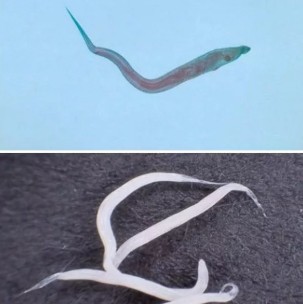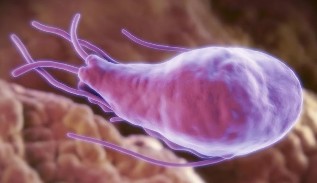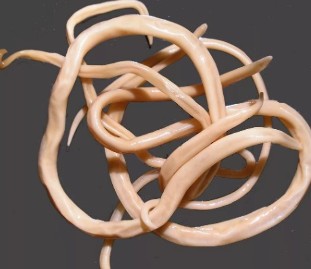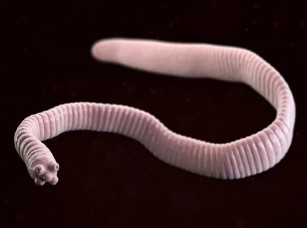The types of parasites in the human body only are many. Their number, along with a lot-mobile phones and protozoa are also viruses, bacteria and fungi that parassitano through the human body, even if in the medical tradition the bacteria and viruses has not decided to give to the parasites.

In the human body different types of parasites that can bring not only in the intestinal tract, as is commonly believed, but in many other organs: in blood, in the tissues, muscles, joints, the brain (the brain and spinal cord) and also in the eyes.
Are particularly exposed to these internal organs such as the GASTROINTESTINAL tract, the liver, the lungs, the heart.
Living parasites in the human body is anything but harmless. Their harmful effects is, first of all, that absorbed a large part coming from the food nutrients, without which the full functioning of the organism impossible.
The imbalance is aggravated also the municipality of intoxication of the human body because of toxins, allocated parasites, which can lead to the development of a series of illnesses up to malignant. Often the diseases caused by parasites, take chronic.
Danger lies in the fact that parasitic diseases are causing the symptoms, which are characteristic for the other, often intestinal infections, therefore of vital importance for the timely differential diagnosis to identify the type of parasite and the production of appropriate physiotherapy tactics.
Types of parasites of man in general can be divided into two large groups:
- ectoparasite-parasites on the body surface and feeding on the blood of people (bedbugs, fleas, lice, ticks) are carriers of pathogens of such infections such as encephalitis, typhoid fever, anthrax, etc.;
- endoparasite-parasites on internal organs and lead to serious diseases; it is to him you refer to, protozoa (giardia, amoeba, trichomonas, toxoplasmosis from the ground...) and helminths – parasitic worms (worms).
Classification parasites

Let's examine the main types of endo-parasites in human. The appearance of many of them you can see only with a microscope, and some, especially among the worms, amazing for its size. Let's start with the simplest:
- Giardia along with dysbiosis are also the cause of hypovolaemia, anaemia and poisoning the general of the body.
- Toxoplasmosis from the earth ... affect the brain, the eyes, the heart muscle, the nervous system, but in particular the danger that they represent for women in pregnancy because of the risk of death of the fetus or heavy its defeats.
- The amoeba can cause amoebic dysentery, the amoebic encephalitis and other dangerous diseases.
- Trichomonas are the sources of infectious diseases of the genitourinary system.
The most common parasites
The most common endoparasite, of course, are the helminths (worms), which, according to various sources, infected more than 80% of the population of the planet.
A huge number of these pests is divided into the main types:
- nematodes – the nematodes (roundworms, ossiuri, trichinella, trichuris trichuris, etc.);
- cestody – band worms (lantecy, beef and pork tapeworm, Echinococcus, etc.);
- flukes – worms-flukes (liver, blood, lung, and flukes live in the intestine).
Sometimes it is possible to meet most of the general classification, according to which all types of parasites, people are divided in:
- intestinal, parasites in the intestine;
- tissue, localized in other organs and tissues.
However, most of the worms in the different stages of its life cycle, the passing of tissue, and intestinal development period with its symptoms.
Consider a brief description of the most common types of worms.
Nematodes (nematode)
- Worm – the most common are the nematodes length from 20 cm to 40 cm, a parasite in the small intestine, but before venturing in the human body, which affects the circulatory and the respiratory system. Together with the intestine of these parasites, it is possible to detect in the liver and gall bladder, heart and lungs. Frequent symptom ascariasis – an allergic reaction.
- Ossiuri – small worms, up to 1 cm, which affects the intestines and consequent enterobiasis with gastro-INTESTINAL disturbances, fatigue, sleep disorders, etc. a Characteristic sign of the presence of ossiuri – itching in the anus, where they lay eggs.
- Trichinella – these microscopic worms (the size of a few millimeters) can lead to serious diseases – trichinosis, which can, if untreated lead to death. The adult species live in the body of the people in the muscles (respiratory, face, etc.), causing muscle aches, fever, swelling, allergic skin rashes.
- Tricocefalo – small worms (up to a length of 4.5 cm, with the front part of the body

The larvae, which cause trichocephalosis with acute diarrhea, abdominal pain and other symptoms similar to those of appendicitis. As A result of poisoning of the body develops anemia.
Band worms (cestody)
- A tapewormbody length of up to 10 m, leads to the development of the difillobotrioz with nausea, weakness, vomiting, a chair unstable, asthenia, and anemia.
- The pork tapeworm has a length of from 3 to 8 m, a parasite mainly in the small intestine, and she immediately called to two diseases: taeniasis with dyspeptic, asthenic-neurotic and abdominal syndromes, and cysticercosis with intoxication, intestinal, allergic, and respiratory syndromes. Depending on the location tsistitserki affects the muscles, the brain, the heart, the eyes, etc
- The bull the tapewormwhose length may reach up to 18 m, causes beef tapeworm infection is considered to be one of the most dangerous types of worms. If you do not make dehelmintization, you can live in the human body for up to 18-20 years! Localized in the colon, causes a strong intoxication products of his life, and even diarrhea, nausea, vomiting, abdominal pain, anemia, allergic reactions, and problems with the nervous system.
- The dwarf tapeworm, a length of only 1.5-5 cm – source the gimenolepidoz with dyspeptic, pain and asthenic-syndrome, neurotic, from which they are suffering, first of all, the digestive tract and the nervous system of the body, and also the liver.
- Echinococcus is considered to be the smallest tape worm – its length is only 2.5 to 8, rarely 9 mm, however, the infection has terrible consequences in terms of damage to the liver and to the lungs where they form cysts and tumors that cause the dysfunction of these organs.

The worms flukes (flukes)
- Liver fluke, or fasciola hepatica form that is reminiscent of a sheet of a length of 30-50 mm and a width of 8-13 mm, equipped with a suction cup. You will damage the sheath of the liver and scoring the bile ducts, can completely cover the flow of bile. Can lead to cirrhosis of the liver, jaundice and cancer of the liver.
- Cat (siberian) fluke, or cats, fluke, flat worm, long, 4-13 mm. Location – ducts of the gallbladder, liver and pancreas. Causes opisthorchiasis with the development of gastritis, ulcers, pancreatitis, cholecystitis up to the cancer of the liver, which can lead to death.
- The lung fluke has the shape of an egg, of a red-brown body with small bits of length from 7.5 to 12 mm and a width of 4-8 mm. Affects the lungs, causing inflammation exudative pleural effusion, fibrosis, focal and lung cancer. In the case of penetration in the brain causes encephalitis and meningoencephalitis.
- Shistosoma (blood flukes) – dioecious worms of the size of 1-2 cm, the eggs that cause enlarged liver, spleen and lymph nodes, the formation of polyps in the intestines, diarrhea, and granulomatous inflammation, which leads to cancer of the bladder.
The sources of infection

Helminthiasis can cause numerous health issues, which reduce the life of 15-25 years. Many parasites are extremely difficult to detect. They can be anywhere - in the blood, intestines, lungs, heart and brain. The symptoms of the infestation of worms infestations may be confused with SARS, diseases of the GASTROINTESTINAL tract and other. The main error in these cases - the delay! If you are suspicious for the presence of parasites, it is necessary to consult a specialist. If you are talking about drugs and self-treatment, from the most common parasites (roundworms, ossiuri, roundworms, tapeworms) suitable antiparasitic complex.
Helminthiasis, as well as other intestinal diseases, often it is disease "dirty hands", that causes a shot of the eggs and larvae of worms in the human body:
- when you do not wash their hands after using the bathroom and before eating;
- do not wash the vegetables, the fruits and vegetables that are consumed raw;
- are not flesh and fish enough to heat treatment;
- when the consumption of the wrong fish, salt and fat;
- are the preparations of the food available for the flies and cockroaches;
- use the feces as fertilizer for the lawn and garden areas;
- bask in is not designed for this the water;
- in contact with those animals.

However, and her pet can also be infected by worms, because, often, animals serve as intermediate hosts for helminths, the primary owner is the man.
Methods of struggle
- From an early age to vaccinate children in the habit of washing their hands. They need to do this, as they are always monkeying in the sand, the ground, puddles, where the most favorable conditions for the eggs and larvae of parasites, and contact with pets and street animals.
- When you get unwell, we can not exclude the bot, then we recommend that you do the necessary analysis on the parasites, in order to define a particular type of helminth (against most of them there are medications.
- If the parasites found a member of the family, the drugs helminthiasis must take all.
- Folk medicine, there are many ways to get rid of the worms, and give a good effect.
- Do not leave open the cooked dishes, bread, baked goods, etc., for flies and cockroaches – the carriers of the eggs of the worms have left their products.
- Observe carefully the temperature during cooking: the meat and the fish, in which often found the eggs of helminths, well-boil/roast the bottom/bake.
- Well rinsed in running water, the vegetables, the fruits, the vegetables, which are consumed in their raw form.
- Do regularly dewormed pets.
- Abandon the use of feces as fertilizer on their garden areas.
- When you are traveling in exotic countries is extremely attentive to the dishes of the local cuisine, in particular, the proposal on the street, there is no guarantee that they do not connect some less exotic worms.






































